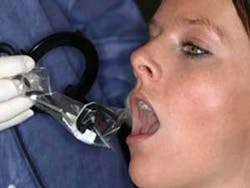Ditch the darkroom
When digital radiography became available in the United States in the 1990s, I MUST ADMIT I WASN’T COMPLETELY CONVINCED THAT THE TECHNOLOGY COULD REPLACE FILM. I decided to make the switch because I spotted a heavily promoted system that supposedly was a “great deal.” Although my patients liked the digital concept, I found the images inadequate for my diagnostic needs. When the company went out of business, I decided to replace that system with quality as the determining factor, and chose a DEXIS® system. In the eight years since then, my digital system has been a reliable workhorse for me, and I have seen incredible results in imaging clarity and detail, work flow efficiency, and cost effectiveness.
Besides intraoral digital radiography, my office is equipped with a digital panoramic X-ray – an essential for dentists like me who like to look at the patient’s “whole picture.” Back in 1984, I purchased one of my most expensive pieces of equipment – a film-based panoramic machine – and kept that same system until last spring.
Through the years, my frustration and costs increased as a result of that machine’s temperamental nature and processing problems. Glitches abounded: sometimes the pano was not geared correctly; sometimes the processor jammed; sometimes we would take an X-ray but forget to load the film; and besides that, copying the film for other doctors was time consuming, and the copies still turned out poorly. The processor and a darkroom, which I no longer needed for my intraoral digital X-ray, remained a burden. Then, my developer broke, causing serious plumbing and construction issues for my office, and after a couple of thousand dollars, aggravation, and wasted time fixing it, I realized that it was time to bid farewell to the darkroom.
I invested in the Gendex® Orthoralix® 8500 DDE – a digital pan unit that just blew me away. Patients are very impressed with our technology, and besides that, just as with intraoral digital X-rays, the image quality is fabulous. Now, my employees don’t have to waste minutes in the darkroom waiting for film to develop.
By the way, have you noticed that time spent developing film in the darkroom seems to have increased since the invention of cell phones and texting? Seriously, now that we don’t need to put up with the time-consuming mess and expense of the darkroom, we can quickly fit taking a pano, even the unplanned ones, into the schedule because it’s just so darn easy and fast to take them digitally. They are the first images we take before PAs on new patients, and we take one for almost every emergency. There’s no time wasted – images appear on the monitor in seconds and are perfect every time.
Patients appreciate looking at the life-sized, detailed intraoral and pano images on a computer monitor, making my diagnosis and treatment plan easier to comprehend. Also, they find the intraoral sensor much more comfortable than traditional film. If a patient is contemplating expensive treatment and comparing different dentists, the digital dentist has an automatic advantage.
I started out a skeptic, but now I am convinced. Besides saving time and money, my digital and panoramic X-rays allow me to offer the most comprehensive diagnosis and treatment plans possible. Now that my office is digital, I am spoiled. It’s not just a luxury; it’s a necessity.
Dr. Lorin Berland is an internationally acclaimed cosmetic dentist and one of the most published authorities in the professional dental and general media. Dr. Berland, a Fellow of the American Academy of Cosmetic Dentistry, is the creator of the Lorin Library Smile Style Guide, www.denturewearers.com, and is the founder of Arts District Dentistry, a multi-doctor specialty practice in Dallas that pioneered the concept of spa dentistry.


